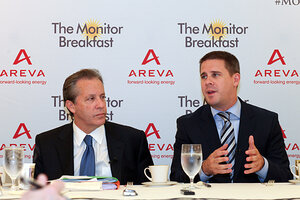Will gridlock ruin Obama's second term? Top advisers weigh in.
President Obama can use executive action and the bully pulpit, pointed out Dan Pfeiffer and Gene Sperling at a Monitor breakfast. Another topic at the breakfast was the president's pending decision on the next Fed chair.

Gene Sperling (l.) Director of the National Economic Council and Assistant to the President for Economic Policy and Dan Pfeiffer, Assistant to the President and Senior Advisor speak at a Monitor Breakfast in Washington, D.C., on Wednesday, July 31.
Michael Bonfigli/TCSM
Washington
Political polarization and gridlock in Washington will not prevent President Obama from having a successful second term, two of his top advisers told reporters Wednesday at a breakfast sponsored by the Monitor.
True, Congress is divided – the Senate is in Democratic hands, the House in Republican – and the president hasn’t signed any major legislation since his second inaugural in January. But senior adviser Dan Pfeiffer and Gene Sperling, director of Mr. Obama's National Economic Council, said the president has plenty of tools to work with. And, they add, don’t rule out the possibility of breakthroughs in Congress.
“The gridlock of the moment is not predictive of what is going to happen in the future on big issues,” Mr. Pfeiffer said.
“If we’d had this breakfast in August of 2011, and I had said to you, the president is going to go out and he’s going to campaign and he’s going to make the case for protecting tax cuts on the middle class and raising the rates on the wealthy back to what they were under Bill Clinton, you all would have laughed me out of the room,” Pfeiffer said.
In December 2012, “the president achieved that campaign promise.”
Ditto comprehensive immigration reform, which passed the Senate in June with 68 votes, including the backing of Sen. John McCain (R) of Arizona, he said.
What Pfeiffer didn’t say is that the issue is stalled in the House, though it’s not dead.
Aside from divided government, Pfeiffer blamed internal Republican divisions for contributing to gridlock.
“The Republican Party is at a crossroads in a lot of ways,” he said. “Some of the biggest fights are now not between Democrats and Republicans, but between Republicans and Republicans.”
Obama has three ways of acting on his agenda, only one of them involving Congress, Pfeiffer said. Congress gets “a ton of attention” because of the politics and the theater, but executive action and the bully pulpit are also important. He named two recent examples of executive-branch measures: new regulations for coal-fired plants to address climate change and an initiative to wire every school in America with high-speed Internet.
The bully pulpit – giving speeches across America, making remarks in the White House briefing room – commands press (and therefore public) attention.
“When the president went into the briefing room to talk about the verdict in the Trayvon Martin case a few weeks ago on a Friday – that’s an example of the president using the bully pulpit to move the country forward,” Pfeiffer said.
He offered some hope on Congress, at least on the Senate side, referring to a “caucus of common sense” there. In addition to passage of immigration reform, a recent deal on filibusters resulted in the confirmations of the new Environmental Protection Agency director, Labor secretary, and members of the National Labor Relations Board.
A big topic of the morning was the president’s pending decision on whom to select as chairman of the Federal Reserve to replace Ben Bernanke, whose term is expiring. But Pfeiffer and Mr. Sperling would not budge.
Speculation has centered on two people: Larry Summers, Obama’s former National Economic Council director and Treasury secretary under President Clinton; and Janet Yellen, vice chair of the Fed’s Board of Governors.
“The president has not made a decision,” Pfeiffer said. “I would not expect an announcement until the fall.”
Sperling said the only person he communicates his views with is the president. But without naming names, he said this of the people under speculation: “I have worked with them, and they are just great intellects. They are outstanding people, and anything I would ever say about either of those people, either privately [or] publicly, would only be extremely positive about both of them.”

